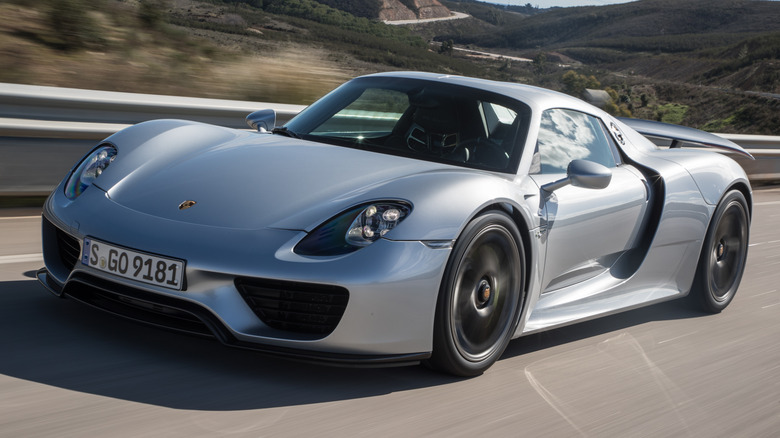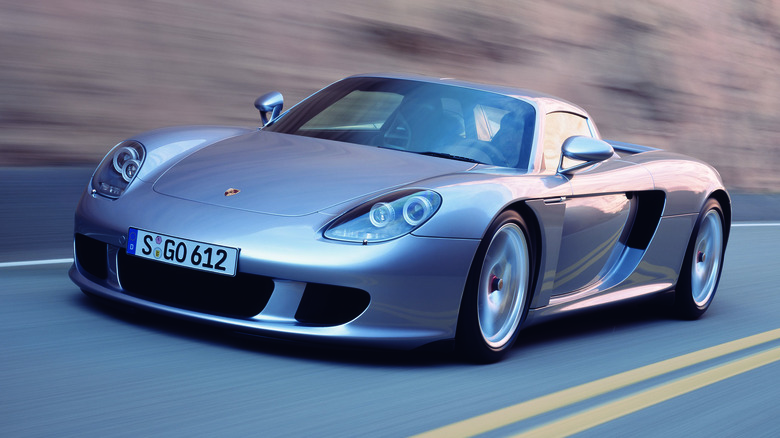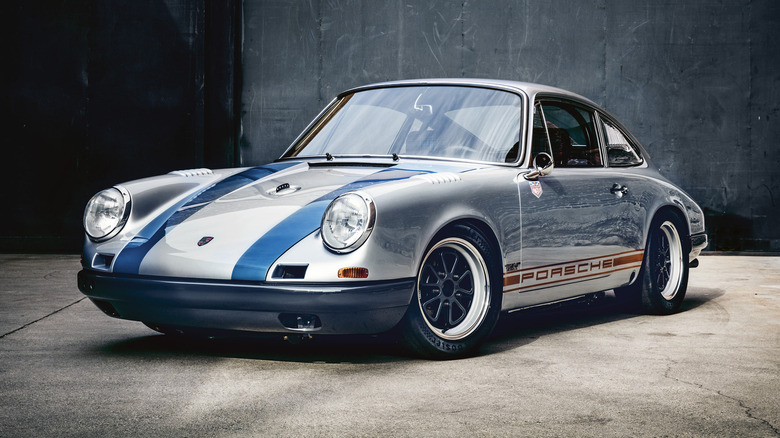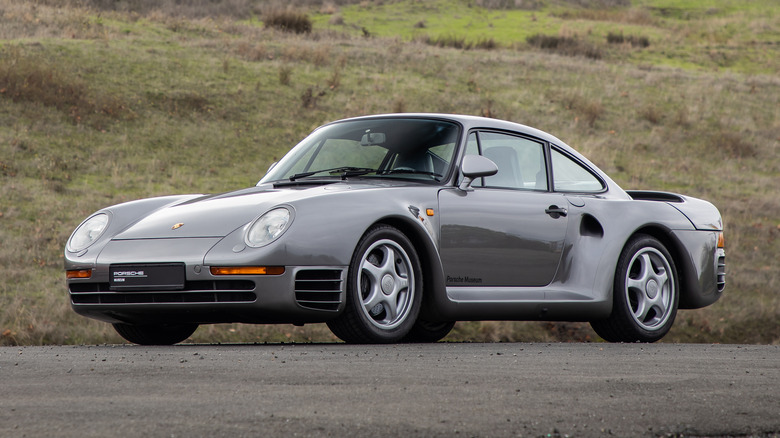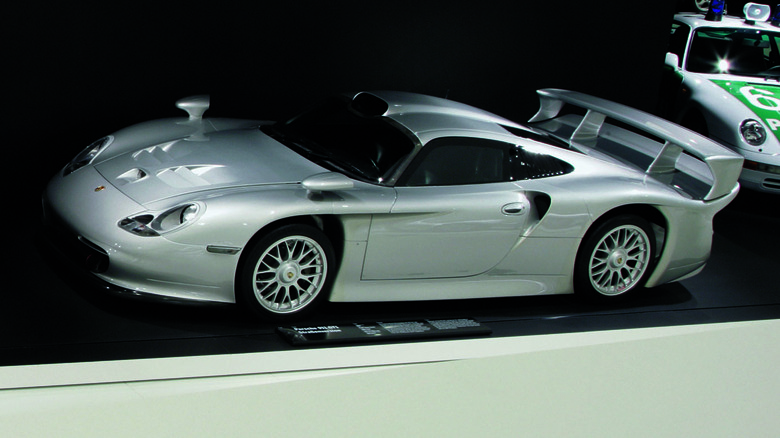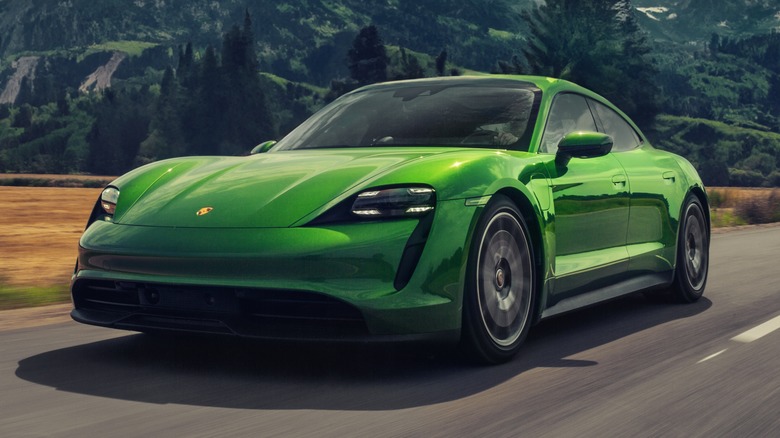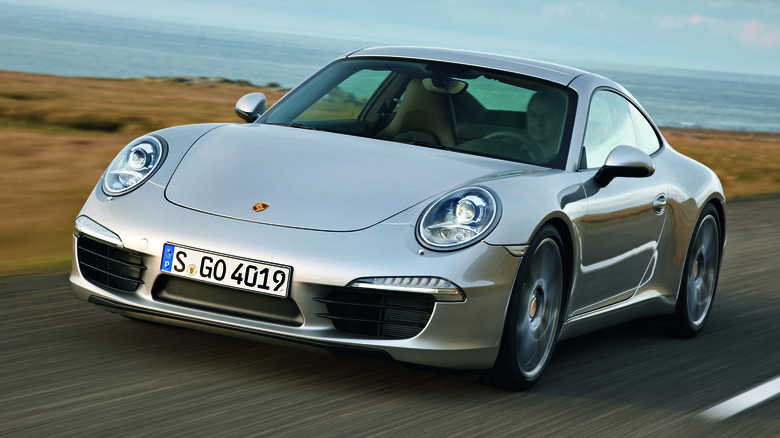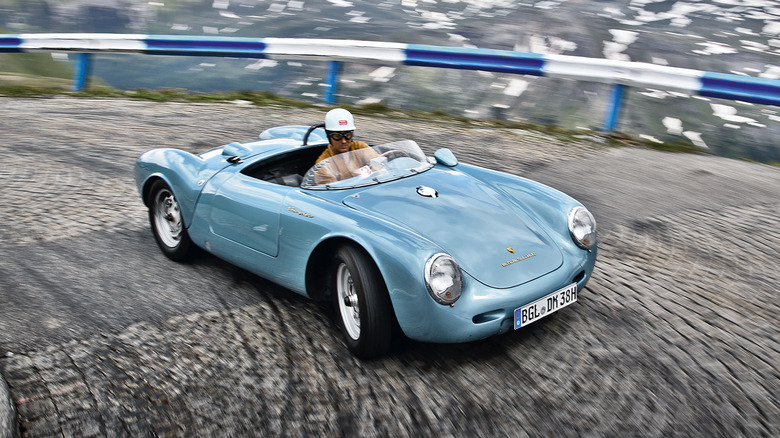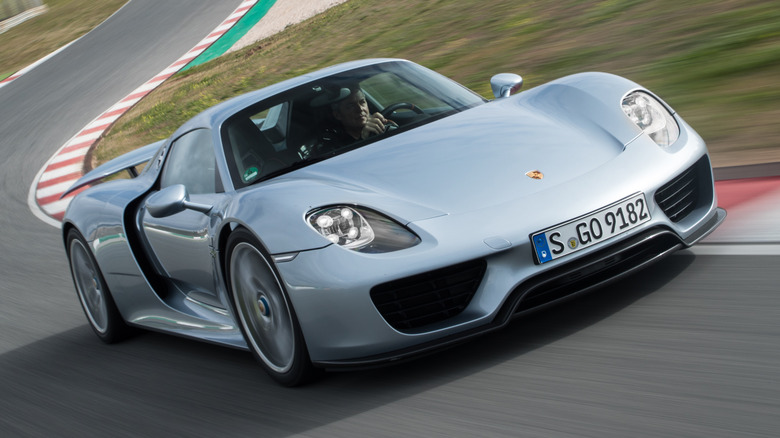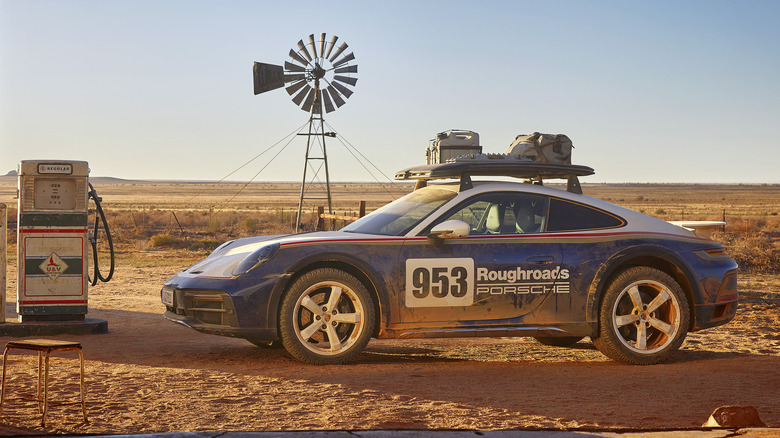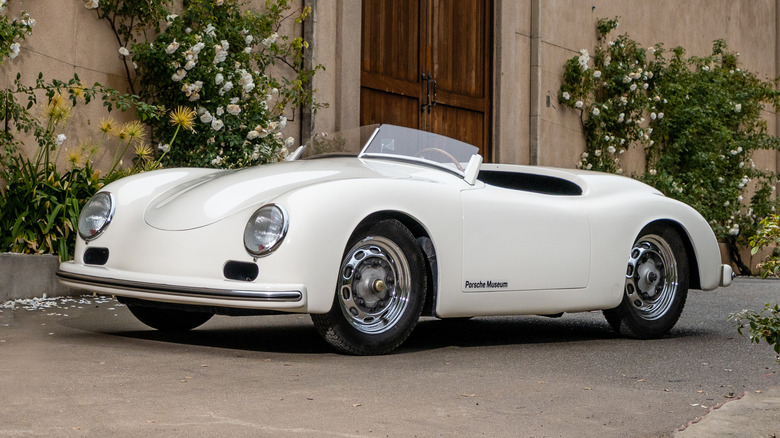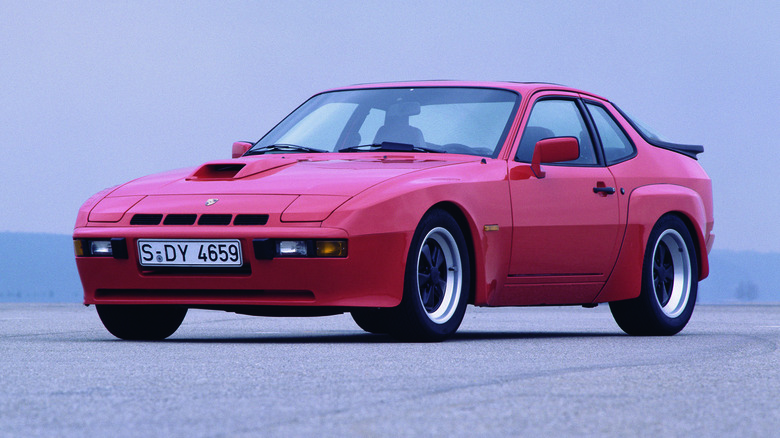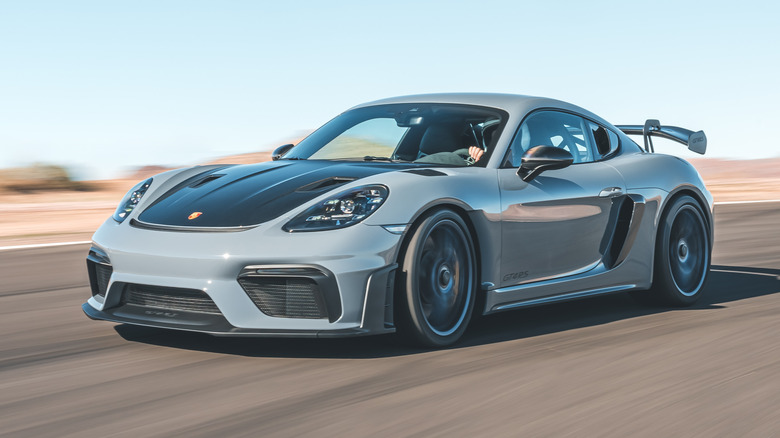The 12 Best Looking Porsche Models Ever Designed
Both on the road and on the track, Porsche has been pushing the envelope of performance for more than three quarters of a century. Its designs, while usually secondary to the performance aspect the cars produced by the company, have also become icons in their own right. There is no better example of this than the Porsche 911 — logic dictates that a rear-engined sports car that can trace its heritage back to a post-war Volkswagen should have been axed decades ago, yet it remains a bestseller to this day. Even when Porsche tried to replace it with the 928 in the '80s, enthusiasts kept buying the 911, in part due to its iconic and unique design.
In recent decades Porsche has expanded its lineup to cover a much wider range of cars, with its highly popular SUVs ensuring the company has the funds to continue developing world-beating sports cars. While neither the Macan or Cayenne are positioned to win many beauty contests, the same cannot be said for many of the brand's other recent offerings. That's in addition to the many classic models that have already made their mark as automotive design icons. We've rounded up ten of the best looking Porsche road cars ever built, including some fan favorites and lesser known picks.
Porsche Carrera GT
The V10 at the heart of the Porsche Carrera GT nearly never made it out of development. It was first designed for use in Formula 1, then when that effort was abandoned, it was reconfigured with the intention of it being used in a Le Mans program. Both times, Porsche bosses made the ultimate decision not to press ahead with entering it in competition, which left the supremely powerful engine without a use. Shortly after the Le Mans program was called off, a proposal was developed to put the V10 into a road car.
A concept featuring the engine in a mid-mounted position was unveiled in 2000 and caused such a stir among the press and public that Porsche executives gave the green light for a production version to follow. That production car was christened the Carrera GT, and unveiled at the 2003 Geneva Motor Show. By that time, its engine had been tuned to produce 600 horsepower, its suspension and chassis had been fine-tuned for road use, and the car had been cloaked in bodywork that managed to be supremely aerodynamic yet also visually alluring.
The car was limited to 1,270 units and, thanks to its combination of beauty and performance, each one was quickly snapped up. The car retailed for $440,000 at launch, but today most examples sell for $1 million or more. Alongside the Ferrari Enzo and Mercedes-Benz SLR McLaren, the Carrera GT is considered one of the "holy trinity" cars of its era.
Porsche 911 (Original)
There are few other names in the automotive world with as much prestige as the Porsche 911. The fact that — after more than 60 years and many distinct evolutions – the basic blueprint of the car remains unchanged speaks volumes about the significance of the original. The first 911 was unveiled in 1963 and designed to replace the 356, Porsche's first sports car. It featured a flat-six engine as opposed to its predecessor's four cylinder unit, but retained its rear-mounted layout.
It proved a huge success for the brand both commercially and critically, selling 111,995 units over the decade it was available. Classic examples are now sought after by collectors, with cars in original, unmodified condition being particularly prized. The first 911 is a simple car by modern standards, but one whose styling has remained timeless and whose driving appeal remains unchanged from the day it left the factory.
Special editions of this generation have become icons in their own right, like the 911 Carrera RS 2.7. Its distinctive duck-tail rear wing became a feature on many later 911 special editions, and the Carrera moniker has remained a mainstay of the Porsche range up to the present day. Like many revered road cars, the car was originally developed as a homologation special to allow Porsche to enter Group 4 racing, but its distinctive dual-color design and Carrera graphics have kept it desirable among Porsche enthusiasts long after its racing days were over.
Porsche 959
A record breaker in several ways, the Porsche 959 was a revelation when it was unveiled in 1986. It was not only crowned the fastest production car ever built, but also managed to be tame and comfortable when driven at everyday speeds. Its racing derived flat-six engine featured two turbochargers, but thanks to their sequential arrangement, the car suffered far less turbo lag than any other car on the road.
The 959's all-wheel drive system was also a leap forward in terms of both technology and performance, developed as a result of Porsche's plans to enter the car in Group B rallying. Unfortunately, Group B was axed before the 959 had the chance to compete, but the 959 proved its worth in a different off-road arena instead. Three prototype examples of the car entered the 1986 Paris-Dakar rally, covering almost 9,000 miles over the course of the event and finished in first and second place positions.
The car was a technological tour de force, but the it's legacy was cemented by the fact that it also looked stunning while achieving previously unthinkable feats of performance. It might have been originally derived from the platform of the 911, but the 959's wider, sleeker stance ensured that it had a curb appeal all of its own. Not to mention, it was significantly rarer and more expensive than any 911, with a $225,000 starting price and production ending after just 292 cars had been built.
Porsche 911 GT1 Straßenversion
While other Porsche design icons combine aerodynamics with timeless elegance or offer technological innovations wrapped in sleek bodywork, the Porsche 911 GT1 Straßenversion is a different kind of striking. Mostly, that's because it doesn't look like it should be wearing a license plate at all. In a sense, it shouldn't — the car was only built as a homologation requirement for Porsche to enter Le Mans, and the road car saw only minimal changes from its race-ready counterpart.
The term "race car for the road" is a cliché, and doesn't quite explain the Straßenversion. This is more a race car for the track that Porsche made the minimum effort to make roadworthy. The few journalists to have driven the car report that it's a challenge to drive, with almost zero visibility, large aero overhangs, and a physically demanding transmission. That's par for the course with any GT1 homologation special, however, as the Mercedes-Benz AMG CLK GTR is reportedly even more of a handful on the roads.
The 911 GT1's flat-six engine is in a different place to any previous iterations of the 911, being mid-mounted rather than rear-mounted. With 600 horsepower on tap, it's also significantly more powerful than almost any other car to wear the 911 badge too. Its visual cacophony of Porsche parts-bin components –- which varied across each year the Straßenversion was produced — make it far from beautiful in the traditional sense. However, few other Porsches can turn heads so easily, whether modern or classic.
Porsche Taycan
Despite the obvious powertrain differences, driving a Porsche Taycan feels a lot like driving any other mass-produced Porsche. Equal consideration is given to performance, comfort, and everyday drivability, meaning that there's fun to be had on the backroads but that the car is just as adept at everyday commuting. It just so happens, of course, that the Taycan is powered by electricity rather than the fossil fuels that propel everything else in Porsche's lineup.
The Taycan was an impressive driver's car from the start, but the list of upgrades unveiled for the 2025 model year should make it even more appealing as a daily driver too. Everyday viability is an important factor, if nothing else because the Taycan is a car that owners will want to be seen in. Despite the significant differences between gas and electric powertrains, and the design challenges those differences can bring to optimizing an EV, the car's designers did a remarkably good job of making the Taycan look like a Porsche as much as it drives like one.
Whether it's in sedan or wagon-like Cross Turismo form, the Taycan looks sleek and well proportioned, without resorting to any of the quirks that EV designers sometimes employ in an attempt to make their cars stand out. There are no oversized aero bits or exaggerated fake grilles here, and the result is a car that is not only one of Porsche's most innovative cars this century but one of its best looking too.
Porsche 911 (991)
Some cars are subject to drastic styling overhauls every few years in order to convey a sense of newness even when the underlying mechanicals have changed very little. The 991 generation 911 was exactly the opposite, being almost entirely new under the skin but carrying over a significant amount of styling from its predecessor. Its chassis, interior, and transmission were all new, making it more powerful, more technologically advanced, and more comfortable than its predecessor. Despite all this, the 991 still clearly resembled all previous generations of the 911.
In fact, it was arguably closer in its exterior design to the original 911 than the likes of the 993 or 996, returning to a simpler, more flowing silhouette. The innovations continued further in the 991's lifespan with the unveiling of the 911 Turbo, which featured active aerodynamics for the first time, while the 911 R drew even more explicitly on the design of its '60s predecessor. While the 997 succeeded in drawing the 911 nearer to its design roots after the more experimental looks of the 996, it's arguably the 991 that stands as the best example of combining classic and modern Porsche design.
Porsche 550 Spyder
The 550 Spyder is infamously associated with James Dean, who was just 24 when he was fatally injured behind the wheel of one. Dean was driving on the highway at high speed in California when he hit another car, and with the 550's spartan design and lack of safety features, he had little chance of survival. Despite its tragic associations, it's the 550 Spyder's minimalist, low-slung construction that keeps it among the brand's greatest designs today.
The car was intended for racing and adapted from Porsche's first car, the 356. Originally, its flat-four engine made just 70 horsepower, but after that output proved inadequate on track, a more potent unit was developed with roughly 110 horses on tap. This added power, combined with the car's extremely light weight, proved to be a recipe for success. The 550 Spyder racked up a number of class wins at the world's most prestigious racing events, including multiple wins at Le Mans. The car even managed to take an overall win at the 1956 Targa Florio, beating more powerful rivals from the likes of Ferrari and Maserati.
The car is designed squarely for racing, but it's this single-mindedness that gives it a unique charm. The ultra-low windshield, for example, was designed to appease racing regulations, while the entire rear bodywork is hinged so that the car's innards can be quickly serviced mid-race. The 550 Spyder was built for the race track, but it's just as capable -– and attention grabbing -– on the road.
Porsche 918 Spyder
Acting both as a technological showcase for its hybrid powertrain efforts and as a limited-run halo car to satisfy wealthy collectors, the Porsche 918 Spyder performed multiple roles for the automaker. Its hybrid 4.6L V8 powertrain would no doubt have been impressive no matter what the car looked like, but it was made even more so by the fact that it was incorporated into such an attractively styled hypercar. The launch press release for the car highlighted its innovative regenerative braking system, carbon monocoque construction, and high level of fuel efficiency. All great leaps in engineering terms, but on their own not enough to excite enthusiasts.
The 918 Spyder's performance provided a much more convincing reason to get excited about the car, with a combined 887 horsepower on offer and a 0-62 mph time of just 2.6 seconds. Its top speed was officially quoted as more than 211 mph, and even in electric-only mode it could reach 93 mph, a very impressive feat at the time for a hybrid.
The car's launch was also accompanied by all the usual talk of setting records on the Nürburgring, although it's safe to say those kinds of claims are far from unique to the 918 Spyder. What is unique, however, is just how well Porsche managed to turn its technological marvel into a piece of rolling automotive artwork. Few other hypercars manage to be so innovative while retaining such timeless looks.
Porsche 911 Dakar
Porsche's history with rallying extends to more than the 959's famous 1986 Dakar victory. A number of rally-spec 911 racers have also seen success at various international events, although none of these off-road Porsches had previously been available for customers. That changed with the unveiling of the 911 Dakar in 2022. With an extensive list of all-terrain modifications, the 911 Dakar comes equipped for gravel, sand, snow, and dirt straight from the factory, and looks very cool indeed while doing so.
Beefy off-road tires and raised suspension are among the most obvious upgrades the car receives, alongside plastic cladding and stainless steel inserts for better resistance to water and dirt ingress. A roof rack can also be fitted with a number of optional accessories including a Porsche-branded jerry can and a roof-mounted tent. The car's limited top speed of 149 mph puts it at a disadvantage compared to other 911 variants on the road, but any owner who uses the 911 Dakar purely as a road tripper is evidently missing the point. This is a car built for any terrain, and unlike most of the Porsches here, it'll look just as good whether it's covered in dirt or sparkling clean.
Porsche 356
The first car sold under the Porsche brand was the 356, which — depending on who's asked — is either a timeless work of art or, as one SlashGear colleague put it, "a stepped-on Volkswagen." The truth is that it's probably a bit of both, with Ferdinand Porsche drawing heavily on his earlier work on the Beetle to create the first sports car marketed under his name. The 356 featured a Volkswagen engine too, which generated just 35 horsepower and made it slow by modern sports car standards. However, because it was so lightweight, it was relatively sprightly compared to what else was on the market at the time, reaching a top speed of around 84 mph.
The 356 was a simple but effective design, and set the blueprint that Porsche would continue to follow for many decades to come. The car's rarity and importance in Porsche history mean that there's a thriving market for 356 replicas today, but none of those highly polished replicas can match the draw that an original, hand-built 356 exerts on any Porschephile. The 356 might not have been the most revolutionary German car -– ironically, it's the related Beetle that arguably deserves that title -– but its revered status as the genesis of all Porsche models give it a head-turning presence even in a crowd of seven-figure classics.
Porsche 924 Carrera GT
It might not be as well known as most Porsche homologation specials, but the 924 Carrera GT follows the same formula as most of them. It's significantly faster than the standard 924, less comfortable to drive, and features a number of race-ready exterior changes that allowed Porsche to take the 924 to Le Mans. It's that last point that arguably qualifies the 924 Carrera GT for this list, despite being a generally overlooked model.
Its wide fender flares, hood scoop, and prominent Carrera branding all add to the classic race car appearance, making the car look significantly faster than it really was. It certainly wasn't slow, but with 210 horsepower on tap from its VW-derived inline-4 engine, it wasn't especially rapid for a sports car of its era either.
Homologation rules required Porsche to build 400 units of the car, with the Carrera GT proving to be more of a sales hit than the standard 924. More than 250 examples had been sold before the car even entered production, and it didn't take long for the rest of the run to sell out. The 924, and as a result, the Carrera GT, isn't given much attention compared to other classics like the 911. Yet, the top-spec variant in its period homologation guise is a funky alternative to the better known classic Porsches of the era, and it arguably looks just as dramatic as any of them.
Porsche 718 Cayman GT4 RS
At the launch of the 718 Cayman GT4 RS, SlashGear noted that Porsche was finally "bringing the 718 Cayman out of the 911's shadow." The top-spec Cayman shared its engine with the 911 GT3, but with its mid-mounted layout, it's the former car that naturally boasts optimal weight distribution. There was 493 horsepower on offer, with the flat-six engine mated to a seven-speed dual-clutch transmission. Top speed sat at a shade under 200 mph, and the sprint to 60 mph took just over three seconds.
As well as being faster than any previous Cayman, the GT4 RS arguably looks better than any lesser variant too. The racing-inspired aero, chunky rear wing, and new wheels give the impression of a pint-sized 911 GT2 RS, although buyers paid for the privilege. The car started at just under $150,000 when it was unveiled in 2022 –- a lot for a Cayman, but then this isn't any ordinary Cayman, either in its appearance or in its performance.
